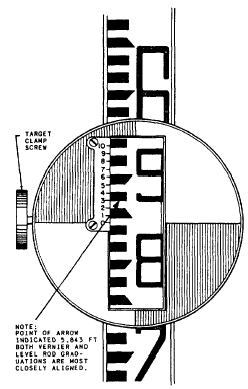|
Making Target Readings The three most common situations in which target
readings rather than direct readings are made
are as follows: (1) when the rod is too far from
the instrument to be read directly; (2) when you
desire a reading to the nearest 0.001 ft, which requires
the use of the vernier by the rodman; and (3)
when the instrumentman thinks a reading by the
rodman instead of by himself more likely will be
accurate.
For target readings up to 7.000 ft, the Philadelphia
rod is used fully closed and read on the
face by the rodman. The rodman sets the target
on the face by the signals from the instrumentman,
who determines when the horizontal
axis of the target intercepts the horizontal
cross hair.
When the instrumentman signals "all right," the
rodman clamps the target in place with the target
screw clamp, as shown in figure 14-9; then

Figure 14-9.-Target reading of 5.843 ft on a Philadelphia rod.

Figure 14-10.-Reading of 7.107 ft on back of Philadelphia rod
as indicated by arrow.
the rodman reads the target vernier, shown in the same
figure.
The reading to the nearest 0.01 ft is indicated by
the zero on the vernier. In figure 14-9, the vernier
zero indicates a reading of a few thousandths
of a foot more than 5.84 ft. To determine
how many thousandths over 5.84 ft, you
examine the graduations on the vernier to determine
the one most exactly in line with a graduation
on the rod. In figure 14-9, this is the 0.003-ft
graduation; therefore, the reading to the nearest
0.001 ft is 5.843 ft.
For target readings of more than 7.000 ft, the Philadelphia
rod is used extended; the rodman makes
the reading on the back of the rod. In figure
14-10, the back of the upper section of the rod
is shown, graduated FROM THE TOP DOWN,
from 7.000 ft through 13.000 ft. You can also
see a rod vernier on the back, fixed to the top
of the lower section of the rod, also reading from
the top down.
For a target reading of more than 7.000 ft, the
rodman, on receiving the signal to "extend the
rod," fixes the target on the face of the upper
section all the way to the top of the upper section.
While doing this, the rodman makes sure the
target vernier is set at exactly the same reading indicated
by the rod vernier on the back of the rod,
He then releases the rod screw clamp and slides
the upper section of the rod slowly upwards until
the instrumentman gives the signal "all right."
When the horizontal axis of the target reaches
the level where it is intersected by the horizontal
cross hair, the instrumentman gives this signal.
|


|

